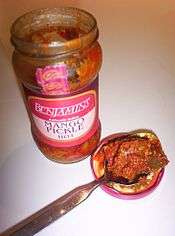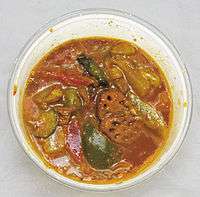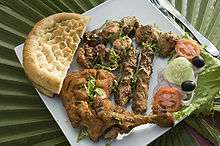Achaar (Desi pickles)
Achaar (or Desi pickles) are foods, originating from the Indian subcontinent, pickled from certain varieties of vegetables and fruits, finely chopped and marinated in brine or edible oils along with various Indian spices. Some varieties of fruits and vegetables are small enough to be used whole. Some geographic regions specialize in pickling meats and fish.
Ingredients
The most common Desi-style pickles are made from mango and lime. Others include cauliflower, carrot, radish, tomato, onion, pumpkin, palm heart, lotus stem, rose petals, ginger, amla,[1] garlic, green or red chili peppers, kohlrabi, cordia, kerda, purple yam, karonda, bitter gourd, jackfruit, mushroom, eggplant, cucumber, turnip and lapsi. In some regions cabbage is pickled with chilies and other spices, similar in style and taste to kimchi.
A wide variety of spices may be used during the pickling process, such as asafoetida, red chili powder, turmeric, and fenugreek.
Homemade pickles are prepared in the summer and are matured by exposing to sunlight for up to two weeks.[2] The pickle is kept covered with muslin while it is maturing.[3] The high concentrations of salt, oil, and spices act as preservatives. Many commercially produced pickles use preservatives like citric acid and sodium benzoate.
Regional variations
Nepal
There are various kinds of pickles in Nepal. Most of them are made with cucumbers, green mango, green and red chillies, lime and carrots. The pickles are preserved in either brine or oil. There are different kinds of recipes according to the region. On the northern side the pickles are normally fermented for a longer period of time and aren’t as spicy as the south. Gundruk (dried spinach and radish) is used mostly on north to make pickles. Southern pickles are mostly preserved in oil and mustard seeds for lemon/lime and cucumbers. They are left to sit on the sun to make them sour. However vinegar-brined pickles specially onions are also popular on the south. There are also various kinds of sweet pickles, almost like relishes; mainly made with melons, mango, apples and lemons.
India

Despite using the same main ingredients, the differences in preparation techniques and spices can lead to a wide variation in Indian pickles. A mango avacai pickle from South India may taste very different from one made in North India—the southern states prefer sesame oil and tend to produce spicier pickles, while the northern states prefer mustard oil. The capital of India, New Delhi is home to many centuries-old pickle brands, such as Harnarains, which has maintained its reputation as one of India's best since it was founded in the 1860s.
In the northern state of Haryana, Panipat is famous for being the hub of making commercial varieties of tasteful achar. Single main ingredient varieties prepared with mango, chilli and lemon are ever popular, but the city is famous of pachranga (literally 'five colors', prepared with five vegetables) and satranga (literally 'seven colors', prepared with seven vegetables) which are matured in mustard oil using main ingredients such as raw mangoes, chick peas, lotus stem, karonda and amlas or limes, pickled with whole spices. Pachranga achar was first created by Murli Dhar Dhingra in Pakistan in 1930, his Dingra and Malik descendants brought it to India in 1943. Panipat produces over INR50 crore worth of achar every year (2016 figures), supplied to local markets as well as exported to UK, USA, UK and the Middle East.[4][5][6]
In Southern India, most vegetables are sun-dried with spices, taking advantage of immensely hot and sunny days throughout the year, thus making pickles an everyday staple. The sun-drying naturally preserves the vegetable, along with spices such as mustard, fenugreek seeds, chili powder, salt, asafoetida, and turmeric. To speed up the preparation process, vegetables may be cooked first.
The states of Telangana and Andhra Pradesh are famous for their spicy pickles. Unripe mango with garlic and ginger (aavakaaya in Telugu), unripe tamarind coupled sometimes with green chillies (Chintakaaya in Telugu) and red chillies (Korivikaram in Telugu) are a staple with everyday meals. Gooseberry (usirikaaya in Telugu) and lemon (nimmakaaya in Telugu) are also widely eaten pickles as well.
The state of Tamil Nadu makes a mango pickle called maavadu, which is usually made early in the summer season when mangoes are barely an inch long. The preservation process uses castor oil, giving the pickle its unique taste. Another pickle from Tamil Nadu is narthangai, consisting of unripe citrons cut into spirals and stuffed with salt. Tamilians also use sun-dried chillies stuffed with salted yogurt, thus making a dry condiment called mor molagai that is typically eaten with rice.
In the state of Karnataka, the tender whole mango pickle is a traditional pickle recipe. This is preserved entirely by dehydrating tender whole mangoes with salt and is very salty and sour. A special type of this is jeerige midi (ಜೀರಿಗೆ ಮಿಡಿ) prepared using special tender mango with a refreshing aroma.
Southern Indians living in the coastal areas also pickle fish and meats. In Tamil Nadu, karuvadu is made by salting and sun-drying various species of fish. Nethili karuvadu, made from anchovies, is among the more popular varieties of karuvadu. In Kerala, tuna and sardines are finely chopped and marinated in spices and later cooked on the stovetop, resulting in meen achar. Andhra Pradesh and Telangana also make fish and shrimp pickles but are more famous for their lamb and chicken pickles, which are known for their spiciness.
Unripe mangoes, lemon, green chilis, gunda (cordia) and kerda are commonly used as key ingredients in Gujarati cuisine. Varieties of pickled mango commonly found in Gujarati households include salted mango pickle made with groundnut oil and spiced with fenugreek seeds, and red chili powder; hot and sweet mango pickle made with groundnut oil and jaggery, fennel seeds, dry dates (kharek), mustard and red chili powder; and hot and sweet mango pickle made with sugar syrup, cumin and chili powder.
Pakistan
Pakistani pickles are prepared using a variety of vegetables, unripe mangoes, and spices in oil. Shikrarpuri achaar and Hyderabadi achar are commonly eaten in Sindh, other parts of Pakistan and abroad.[7]
Other regions
In South Africa, Indian pickles are sometimes eaten with bread, and are often referred to by the word achar (also via the Dutch atjar). A well-known commercial pickler is Packo.
Mango pickle (သရက်သီးသနပ်) (thayet thi thanat) is commonly used as a condiment alongside curries and biryani in Burmese cuisine.
In Mozambique, lemon and mango achar is widely eaten and is used on the side for many dishes. Brought over from the Indo-Portuguese cuisine, it infused with the local dishes.
See also
- Indian relish
- Acar, vegetable pickle from Indonesia, Malaysia, Brunei, and Singapore
- Atchara, pickled unripe papaya from the Philippines
References
- ↑ Navya Malini (10 August 2013). "Recipe: Sweet and sour berry pickle".
- ↑ "Pickling in the hot sun". Archived from the original on 2014-02-17. Retrieved 2014-02-17.
- ↑ Mango pickle recipe
- ↑ Our desi drive-ins
- ↑ Spice of life: Surrender to Panipat pickle!, The Tribune, June 2016
- ↑ The road to Kashmir through Haryana
- ↑ "All you need to know about Shikarpur's pickle". Daily Times. 1 October 2017. Retrieved 13 January 2018.




